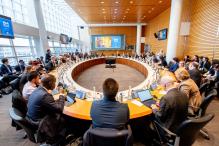The following is a brief overview of the forthcoming Oxford Handbook of Indian Foreign Policy, launched in New Delhi on 11 September 2015.
Why this Oxford Handbook?
In mid-2012, Oxford University Press suggested that, in view of India’s growing weight in international relations, the time had come for a volume devoted to Indian foreign policy in OUP’s flagship series of reference volumes in subject areas ranging from mathematics to politics and international relations. We, the editors, each had published on aspects of the topic, and were familiar with the wide variety of high-quality scholars and practitioners who might be approached to participate.
Relevance of the Handbook Subject Matter
During the Cold War, India’s international profile was above all identified with non-alignment and solidarity with colonized, newly decolonized and other developing countries. In the West, India was broadly tarred as moralistic and hypocritical. While this view conveniently ignored serial Western hypocrisies, it is true that India’s relations with some immediate neighbours hardly lived up to the standards it was preaching from global pulpits. The end of the Cold War and internal economic pressures forced New Delhi to re-think of many of its international and economic policies. Together, these shifts introduced a two-decade long evolution of Indian foreign policy not so much in a straight line as in a set of fits and starts.
By the turn of the century, the number of scholars and practitioners with in-depth knowledge of India multiplied worldwide. Within India, scholarship took a more critical turn, analysing the specificities of New Delhi’s international relationships, international objectives, and policy implementation. Country and regional expertise began to incorporate new theoretical and methodological approaches. In consequence, the range of views and the community of scholars and practitioners interacting with each other grew significantly. And as India’s economic growth accelerated, the country’s international relations became much more relevant to a wide range of international actors.
The Rest of the Field
Early on, Kanti Bajpai offers a rich essay on the relevant literature. From fairly intense interaction with the rest of the world, as of the late 1960s, India turned inwards and its academic links with the rest of the world began to diminish, while the Indian education system became more centralized. Consequently, Indian scholars tended toward explicating and extolling official positions on international relations rather than questioning them.
Academic scholarship on India’s foreign policy took on a more independent form from the 1990s. The turn of the millennium also saw a greater awareness of the need to revitalize the discipline in India by strengthening old teaching and research-based institutions and building new ones. With India very much à la mode, the quantity and quality of Indian scholarship has expanded significantly.
The last Indian survey on the model of this one of which we are aware is a monumental, authoritative one edited by Atish Sinha and Madhup Mohta in 2007, Indian Foreign Policy: Challenges and Opportunities, handsomely published by the Indian Foreign Service Institute. Its excellent authors were nearly all practitioners of scholarly bent, whereas in this volume, most are full-time scholars, many with a strong interest in policy.
Just as the United States and Britain feature much literate and acute newspaper, periodical and journal writing on international relations, so does India. It is home to a thriving and highly profitable media industry, notable for the often sensationalist but equally often compelling writing on international relations, much of it in English. Several of our authors and one of the editors bestride the worlds of scholarship and media commentary.
One of this volume’s most welcome revelations is the flowering of a talented younger generation of scholars who will doubtless fill the theoretical near-void on our topic in years to come. Thus, the field is almost certain to prosper and grow in years ahead, both inside and outside India.
Our Construct
This volume is structured around four main factors that shape, power and constrain any country’s foreign policy: history, geography, capability and leadership.
History
Although fragmented through most of the last three millennia into many smaller polities, in the modern period, India gradually became a unified territorial entity under the authority of the British Raj. While the Raj tends to be remembered with a touch of nostalgia in the West, its legacy in India was far from an unalloyed blessing. It laid the institutional basis of a modern state and sought to integrate India with the global economy, but its economic record was at best mixed, its administrative performance frequently feckless and its political stance deeply and permanently divisive. This experience profoundly shaped post-independence India and its foreign policy, breeding lasting suspicion of Western hegemony.
However, the Raj also left a different, more positive legacy. It incubated an Indian elite steeped in the values of political liberalism, which under the leadership of Nehru, built one of the earliest and most successful democracies outside the West. Much like the Raj, which emulated the Mughal Empire in many ways, independent India incorporated many institutions left behind by the Raj, including armed forces subordinated to civilian control and an experienced if small bureaucracy, including a diplomatic staff.
Geography
Although India is to a degree cut off from neighbours by the Himalayas and by its extensive coast-line, its neighbourhood is a tough one, marked by competition and conflict. India’s most consequential and contentious land borders are with Pakistan and China. All three countries are armed with nuclear weapons. India also shares borders with Bangladesh, Myanmar, Nepal and Bhutan. In India’s mind, Afghanistan is a close and important neighbour, even though territorial contiguity was extinguished in 1947 with the creation of Pakistan and loss of the Northern Areas of Kashmir in the 1947-48 Kashmir conflict.
Across the seas, India considers Sri Lanka and the Maldives as close neighbours, while it also enjoys a special relationship with Mauritius, whose population is of mostly Indian origin, despite considerable geographic distance.
Beyond these immediate neighbours, India’s extended neighbourhood includes Iran and the Persian Gulf, and through Myanmar and across the Indian Ocean shades into South East Asia. Meanwhile, India’s large and entrepreneurial Diaspora extends India’s sense of connection to Malaysia and Singapore in South-East Asia, Africa, the Caribbean and to other lands as distant as Fiji. With Saudi Arabia and the sheikhdoms of the Gulf fast developing their countries, large Indian Diasporas provide some of the mid-level professional and much other labour required by the ambitious infrastructure and wider economic plans of these countries. India’s growing energy demand is met by ever expanding energy imports from the oil-rich Middle East and has provided a strong economic interdependence with the region.
Capability
A country’s capability depends on a number of factors, but none is more important than the health and dynamism of its economy. On this score, until the 1980s, India’s record was generally dismal. At independence, India accounted for less than 2% of global wealth, despite having 345 million people to provide for. While the colonial state had integrated India into the first wave of globalization and fostered some industrialization, its share of the global GDP and trade steadily diminished after independence until the 1980s.
When the British started their expansion into India in 1700, the country accounted for 24-25% of global production, according to studies cited in the volume. The UK’s GDP at the time amounted to little more than 11% of India’s, but by 1947 it exceeded India’s by half. Looked at another way, India’s GDP per capita remained essentially flat during the 200 years of British domination, while the UK’s GDP per capita increased five-fold. Thus, Nehru and his colleagues in 1947 faced a very bleak economic picture.
Since then, a constant until quite recently was India’s weak capability to implement its international ambitions, in the instances when it was able to formulate them. Indeed, policy in a number of fields has been confused and contradictory. For example, this volume advances a strong argument that, India’s often large weapons imports are necessitated by the failure of much of its defence industry to provide high quality output, which stands in contrast to successful nuclear weapons and space programs.
As of the 1990s India’s private sector came into its own, as discussed by Rajiv Kumar in Chapter 19. The Indian private sector boasts a number of highly successful business empires, but many of these companies, such as Mittal Steel, succeed better outside India than within due to the domestic burdens of bureaucracy, corruption and frequent contestation. The outlook for India’s economy, while hopeful, is still clouded by uncertainty over whether such systemic challenges will be overcome.
Leadership
Two Indians stand out globally as among the twentieth century’s most appealing leaders. The first is Mohandas Karamchand Gandhi, who drove India’s 40-year independence movement, but never held political office and was assassinated in 1948, and thus does not appear much in the volume. Second is Jawaharlal Nehru, the first prime minster of independent India, who advocated passionately for those still under the colonial yoke while helping to shape the notion of non-alignment in the unforgiving climate of the Cold War.
His daughter, Indira Gandhi, gained some admirers internationally, but made few friends for India. India’s first nuclear test in 1974 alarmed much of the world, and led to a form of purdah for India among nations endowed with nuclear technology. Nevertheless, she remains wildly popular among her own people as a leader who “stood up for India”.
No subsequent leaders rivalled Nehru and Indira Gandhi on the world stage. Rajiv Gandhi championed the fight against apartheid but also launched an ill-fated military intervention in Sri Lanka under the guise of peacekeeping between 1987-90, and he initiated moves that would influence the transformation of Indian foreign policy during the 1990s and beyond. Of his successors, Narasimha Rao (1991-96) stands out as having engineered India’s deft response to the end of the Cold War. I. K. Gujral consistently championed more generous relationships with India’s neighbours under the so-called Gujral Doctrine.
Atal Bihari Vijpayee, Prime Minister in 1996 and again in 1998-2004, was the first government leader of the Bharatiya Janata Party (BJP) and proved a deft hand both at engaging Pakistan while also skilfully dealing with Islamabad’s military venture into Indian-held territory at Kargil in 1999.
The two Congress-led coalition governments of 2004-09 and 2009-14 will be remembered above all for the delicate and controversial dance between Prime Minister Manmohan Singh and the administration of US President George W. Bush to secure an agreement on civil nuclear cooperation in 2008, notwithstanding the fact that most of India’s international nuclear cooperation ground to a halt in the wake of the sweeping Civil Nuclear Liability Act passed by the Indian Parliament in 2010.
Each of these episodes and personalities are explored in some depth in the volume.
With the BJP’s arrival in power in 2014, the country’s new Prime Minister, Narendra Modi, playing against expectations, launched a charm offensive vis-à-vis India’s neighbours, including Pakistan. He radiated intent to see India prosper, not least due to greater international investment and trade. However, his confident style and the growing global relevance of India have not yet, beyond tone, yielded significant change in India’s international stance, which could well evolve in years ahead as it is still very early days for his government.
Multilateral Matters
During Dr. Singh’s years, India’s international profile grew in tandem with the country’s economic success. New Delhi articulated a strong claim to a greater role in global governance, which was achieved to a certain extent with the creation of the Group of 20 at the head of state level in 2008 and by the creation of new plurilateral forums such as the BRICS.
One chapter discusses the importance of the UN in Indian foreign policy going back to its early years, while another addresses India’s growing voice and growing frustrations within a number of international institutions. India’s position on climate change is considered in a forward-looking chapter near the volume’s end. While recognizing the need to act on the issue domestically, Delhi has maintained an increasingly lonely position at the global level favouring the “status quo” established by the Kyoto Protocol in 1997, unlike China.
Key Relationships
It is the unhappy lot of editors to have to make choices. This responsibility came into focus most sharply when we began to discuss India’s most important relationships beyond its immediate vicinity. Some, like the USA, Western Europe and the Russian Federation were obvious. Others required greater thought. We ultimately provided for two chapters on India’s relationships with Africa, one on Brazil and another on Israel (having dealt with the Persian Gulf states, as part of India’s extended neighbourhood).
New Delhi’s relationship with Tokyo has been intensifying, particularly since the election of Shinzo Abe as Prime Minister of Japan in 2012, in part as a result of tectonic shifts underway in Asia related to the accelerated rise of China, and in part because Prime Ministers Abe and Modi had developed a close political relationship going back a number of years. Though not discussed in depth here, India-Japan relations will be the focus of a separate volume, in some ways a spin-off of this one, to be published by OUP in January, 2016 with distinguished and exciting contributors from both countries, edited by Rohan Mukherjee and Anthony Yazaki.
We might have sliced and diced our rich subject matter differently, and perhaps should have, but we hope our structure can help illuminate this rich topic for our readers.
Access The Oxford Handbook of Indian Foreign Policy here.
We would like to gratefully acknowledge our generous donors: the International Development Research Centre and the Centre on International Governance Innovation, both of Canada, as well as the Observer Research Foundation in Delhi and the Indian Centre for Policy Research (where the project was headquartered, and which is not to be mistaken with UNU-CPR).



